Abstract
Appropriate daylight control could maximize occupants’ visual comfort, potentially saving energy. However, the deployment of daylight control systems (DLCSs) is not happening, mainly due to the complex system calibration and the frequent reluctance of occupants toward automatic control systems that exclude their participation. In this paper, a human-in-the-loop DLCS is presented. The system is designed to allow the users to have direct interaction via smartphone Bluetooth communication, enabling them to set the lighting values deemed most comfortable nimbly. Special attention has been paid to the power consumption of the DLCS, especially in standby mode. Accessibility of configuration has been taken into consideration, leading to the choice of a wireless configured device. The performance of the prototype DLCS was evaluated experimentally in a side-lit room and compared with that of a commercial controller. The illuminance on a reference work plane was measured during the operation of the systems to observe the controllers’ effect on the lamp’s luminous flux while simultaneously considering the variation of daylight conditions. Moreover, the energy performance of the systems was studied to obtain information about the energetic effectiveness and convenience of the studied DLCSs. The main results showed that the proposed system could maintain the required target illuminance values on the work plane as daylight conditions vary: the maximum deviation measured using the prototype never exceeded 11 lx. In comparison, the commercial controller reached peaks of 220 lx. Moreover, the energy consumption of the prototype (resulting equal to 370 mVA) was lower than the consumption of the commercial system (equal to 600 mVA), allowing for increased energy savings over the long period. The more straightforward configuration allows the user to better interact with the DLCS.
1. Introduction
Almost one-third of the energy used worldwide is consumed by buildings [,]. The building industry is receiving special attention from national governments and international organizations worldwide as they develop new energy policies and push for adopting more sustainable and energy-efficient building solutions [,,]. On the one hand, specifications have been established to create brand-new, high-performance structures that consume almost no energy. Action plans, on the other hand, are suggested for remodeling the current building stock.
Buildings currently use much more energy than they should because of outmoded construction methods, inefficient systems and equipment, and weak technological control systems [,,]. Hence, achieving new efficiency targets depends heavily on improved control strategies.
Daylight control in buildings is an essential aspect of sustainable design, as it provides numerous benefits for building occupants, the environment, and energy consumption [,,,]. By utilizing natural light as a sustainable resource, buildings can reduce their reliance on artificial lighting, improve energy efficiency, and enhance the overall well-being and productivity of occupants, contributing to reducing carbon emissions. In addition, daylight control systems (DLCSs) can also improve the indoor environmental quality of buildings by reducing glare and excessive heat gain from sunlight, which can lead to uncomfortable and unproductive indoor environments []. This plays a significant role in improving the comfort and well-being of building occupants. Daylight has been shown to positively impact mental and physical health, including increased productivity, reduced stress levels, and improved sleep quality []. However, inadequate or poorly controlled lighting can lead to eye strain, headaches, and other health problems. By incorporating daylight control strategies, such as automated shading systems and light sensors, buildings can optimize natural light levels and create more comfortable indoor environments.
Effective DLCSs in buildings require a combination of advanced technologies and thoughtful building design []. For example, buildings should maximize the amount of daylight entering indoor spaces while minimizing glare and excessive heat gain. This can be achieved using skylights, light shelves, and other design strategies. Additionally, automated shading systems and light sensors can regulate the amount of daylight entering indoor spaces, depending on the time and the amount of daylight available [].
Studies demonstrate the energy savings potential of integrated daylight and artificial lighting controls to be from 30 to 80% in lighting energy [,] and from 3 to 40% savings in heating, ventilation, and air-conditioning (HVAC) systems’ energy consumption [,]. Lighting accounts for a sizable fraction of the electrical energy used by non-residential and commercial buildings, particularly those that have not yet undergone a complete light-emitting diode (LED) lighting retrofit []. To this extent, one of the sector’s primary goals in recent years has been to increase energy efficiency by cutting back on lighting energy. Various concepts, strategies, and technologies have been implemented to accomplish these goals. The saving performance is, however, dependent on several variables, including the country’s climate [], the building’s orientation and its surroundings, the occupancy profile of the room, the reflectances of the inner envelope, the distance between work plane and window, and the dimensions and geometry of the window. The building’s design and the shape of the rooms are also fundamental factors [].
2. Background Knowledge and Research Aims
The design of a DLCS is quite complex because there are numerous variables to be considered, for example, the space configuration, control strategies, type, location, and number of photosensors to be installed. In addition, a DLCS should consider the user as an active participant and, therefore, be adaptive according to the user’s preferences. The illuminance threshold values provided by standards, often considered excessive for the user, should not be the only design benchmark. In fact, for the latest generation of DLCSs, the design approach is based on occupant-centered control (OCC). According to Park et al. [], DLCSs can use “occupancy-based control”, i.e., control of building systems based on the absence/presence of occupants; and “occupant-behavior-based control”, whereby systems are controlled by correlating environmental information (e.g., illuminance) with human–building interactions (e.g., light switch). An example of sensor-driven, human-in-the-loop lighting control is proposed by Tan et al. [], where the user feedback is incorporated into the system, as a result of an image captured by a smartphone that, through an algorithm, determines the dimming levels of the luminaires until the users’ desired illuminance levels are achieved. Several closed-loop DLCSs were evaluated in the work of Bellia and Fragliasso [], based on different control typologies: switching, two- and three-level stepped systems, proportional dimming systems, and integral reset systems. The results showed that the proportional dimming system was found to provide the best performance, although the search for the best strategy should be carried out on a case-by-case basis based on a detailed study of daylight.
Given the complexity of the problems related to DLCSs, their diffusion still needs to be improved, despite the significant energy and comfort benefits that their installation could bring about []. The leading causes that limit their diffusion are:
- design difficulties;
- installation problems;
- the difficult calibration phase of the photosensors;
- the onerous evaluation of the actual energy savings that can be achieved (with modeling tools;
- the poor acceptance of automatic light changes by the user.
Moreover, the sensor placement and operation choice are still widely debated and unresolved []. Ideally, a DLCS should measure the illuminance value on the work plane, even though the movement of the occupants could greatly distort this information. In some cases, therefore, the installation of sensors on users’ clothing or glasses is proposed. However, the most common location is on the ceiling []. Through some calibration methodologies, the illuminance on the work plane is evaluated as a function of the illuminance measured on the ceiling. It is worth noting that the calibration phase is a significant critical issue that often prevents the widespread installation of DLCSs [].
A further penalizing aspect is the type of environment in which the installation of a DLCS is considered. In fact, in individual spaces, it is relatively easy to define a desired illuminance value; in shared spaces, determining optimal illuminance levels for all users is complex and generally a problem that needs to be solved. Therefore, it is necessary to search for new solutions that can enable a greater diffusion of daylight harvesting systems, as a result of which necessary energy savings and better visual comfort for the user can be achieved.
In this work, trying to overcome the limitations that characterize DLCSs, described earlier, preliminary experimental results of a new human-in-the-loop DLCS prototype are discussed. The prototype is based on a new approach that allows an easy and fast configuration since it prevents manual access to the controller as a result of smartphone Bluetooth communication. The system, based on a user-friendly digital addressable lighting interface (DALI) controller that operates in wireless mode, allows the user to be easily included in the lighting management. Moreover, the system modularity and portability are increased as a result of the technologies employed, as, in this case, the protocols are not ad hoc but support a wide variety of lighting elements and user connection devices. These features are essential in overcoming design and installation problems. Another design specification of the prototype relates to its energy absorption, which is generally an additional limitation to the deployment of DLCSs, especially in rooms with low lighting power density (LPD) and low utilization coefficients.
The analysis was conducted experimentally in a room of the “G. Parolini Lab” of the University of L’Aquila, comparing a commercial DLCS and the proposed prototype. The experimental campaign occurred on different days and times in February 2023 and November 2023.
3. Related Works
The topic of daylight control is, as previously introduced, complex and widely discussed in the scientific literature. Several methods used for DLCSs have been studied in previous works. Light sensing by means of light sensors is not the only available methodology; hence, this section gives a short insight into other available solutions.
This section is divided into three paragraphs, reporting research works dealing with daylight harvesting and control systems. The control systems can be differentiated between image-sensing-based and illuminance-sensors-based. On the actuator side, the illuminance can be managed by dimming the luminaires or controlling the windows’ shading []. The luminaires can be of various types, all electrically controlled by varying the power supply.
In the scenario of daylight control, the research shows efforts in both luminaire control and shading techniques. Glaring windows are based on chromogenic materials Fare clic o toccare qui per immettere il testo., as a result of the function of dynamical glazing. The function of a chromogenic window is to control the flow of light into and out of the glazing according to occupant comfort. Moreover, these windows can regulate lighting and solar heating levels for energy management. These elements, however, can introduce cost increases in construction and maintenance processes [] and often require ad hoc control elements that are less modular with respect to lighting controllers [].
This study deals with a luminaire control system, but the principle of operation can also be specialized to electrically controlled shading elements.
3.1. Image-Sensing-Based Lighting Control
The powerful capabilities of image sensing can be applied to controlling lighting. Image analysis techniques are often applied to this kind of system, enabling a wide spectrum of processing capabilities oriented to optimal daylight tracking and control [,,]. Image sensors are usually used with processing units such as dedicated computers or custom digital processing platforms, often based on field programmable gate arrays (FPGAs) [,]. Imaging control systems introduce flexibility in the processing chain; however, they can be more expensive than light-sensors-based ones for some smaller applications in terms of hardware and energy requirements. The highly sensitive nature of images also makes security and privacy in visual sensing (VS) an important factor in inhabited building daylight monitoring []. For the aforementioned reasons, imaging-based DLCSs can be considered a separate category with respect to light-sensing-based DLCSs.
3.2. Light-Sensing-Based Lighting Control
The sensing-based DLCS is widely employed, as the previously cited works report. Research has shown that many factors affect the commissioning of DLCSs, such as the space constraints, the type of control, the position and number of photosensors and luminaires, the anticipation of user needs, and actual preferences, among others. The authors of [] analyzed these factors in a comprehensive review.
The systems available in the literature employ different architectures and electronic devices.
Generally, the structure of a DLCS can be described as shown in Figure 1. A light-sensing element produces an output related to the quantity of light captured at a desired interface. The photosensors can be digital or analog and are interfaced with a control unit, usually microcontroller-based. These data are processed from a controller unit to achieve a signal used to dim the light to obtain a desired illuminance value at the measuring point on the work plane.
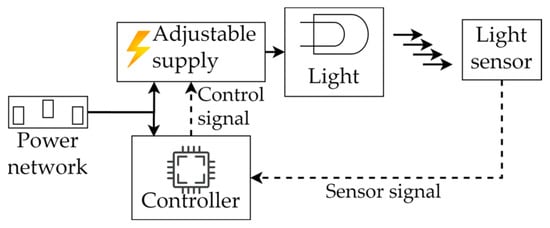
Figure 1.
General scheme of a DLCS.
The dimming is achieved using an adjustable lamp supply. The setting of the desired light intensity can be carried out with manual hardware inputs, such as potentiometer knobs on the controller, or using software interfaces that facilitate the user experience, then creating a human-in-the-loop control system. The placement of the light sensors is an actual and widely discussed aspect. The most frequent possibilities proposed in the literature are ceiling-mounted units or work-plane-located elements []. In the following, a brief overview of the state-of-the-art of DLCSs is given.
The authors of [] proposed a presence-based system for the control of LED panels. An ultrasound proximity array is used to obtain the location of the occupants of an office, and then the data are used to dim the light to optimize the illuminance as the trajectory of the occupant indicates.
In [], the authors adapted dimming levels of artificial light sources with changing daylight, following lighting constraints specified at the horizontal work plane of an occupant. The light sensors were installed at the ceiling, and additional prior information from sensor calibration was given in the input to the control algorithm. The study was at the simulation level, where photometric data were used to achieve a solution where knowledge of the illuminance mapping from the light sensors to workspace illuminance values was available. The achieved illuminance was found to be close to the achieved illuminance when the light sensors were located at the work plane. A distributed lighting control system under two networking scenarios was presented in []. The controllers were set to achieve an illuminance value at the work plane. This study considered two controllers of proportional integral (PI) types configured in stand-alone control. A classical controller was employed to track a reference, while offset-biased PI controllers were used to track a reference with a positively biased offset. The latter controllers reported a stable, steady state with an overshoot within the required limits for most of the simulation instances. A review of the control approaches is reported in [].
In the literature, we have found various implementations of DLCSs. Those often share the control principles but have different hardware implementations.
A smart lighting system based on a distributed wireless sensor network (WSN) is presented in [], reporting a description at the hardware and functionality level. The nodes consist of occupancy sensors based on passive infrared (PIR), microwave Doppler sensors, and an ambient light sensor. The dimming level of each luminaire was controlled considering the occupancy and the daylight intensity. The performance of the proposed system was evaluated in two different scenarios, namely, a metro station and an office room, showing how the system can introduce important energy savings.
The authors of [] analyzed the saving potentials of an occupancy-based system using an on/off behavior for the luminaires. The results showed that energy savings were obtained by implementing a fixed illuminance level control system. A comprehensive study was conducted in [], where the authors organized 60 office cells with an adaptive lighting system to analyze the impact on the power network load. The system allowed the arbitration of the contribution of daylight from the prediction work plane illuminance and daylight glare probability.
In [], the authors implemented a DLCS using a Raspberry Pi [] calculator. In this case, the system was composed of distributed elements: the sensor was located on the work plane. The control unit was attached to the luminaire panel, and sensor data were retrieved wirelessly using ZigBee []. Illuminance measurement data over some test time slots were reported, along with energy measurements that showed the savings achieved.
In [], the authors presented a partial feedback control for LED luminaires powered with a pulse-width modulation (PWM) waveform. In particular, the controller received the input during the off-time slot of the PWM signal and used the daylight to regulate the supply power for the on period, considering the light’s afterglow. The study reported that direct sunlight can influence the control system, creating unwanted spikes in illuminance, while scattered light allowed for a better system working. In [], the authors proposed a daylight and occupancy control system for academic classrooms based on a dimming circuit implemented with the direct switching of the grid network using a metal oxide semiconductor (MOS) power transistor. The results included a detailed economic analysis of the lighting solutions and control system.
Historic buildings usually fail to meet the more modern constraints on energetic consumption, including light-related ones. Having the right illuminance value on all surfaces is often a problem in old buildings. In [], the authors proposed a system that is useful to enhance the lighting characteristics of an office in a historic building, combining window shading with LED control. The setting of light color, intensity, and window shading was manually carried out by the occupants.
The study in [] focused on the fatigue of individuals and developed a lighting solution to assist occupants in psycho-physiological recovery once they return home. The occupant activity information was analyzed using a mobile application, and then the data were transmitted to a cloud-based platform, which outputs the light setpoint for luminaire control.
Reference [] presents the integration of an algorithm for sensor blockage detection by employing machine learning. This approach can be useful for the correct achievement of power savings in case of sensor malfunction or obstruction, considering that, if the photosensor is placed directly on top of the work plane, the occupant’s behavior can cause its obstruction.
In [], the authors proposed a prototype system for light control to facilitate people’s reading. The aim was to give users their desired illumination in advance by detecting the physiological state via the brain–computer interface. The experimental results showed that the developed system successfully increased user attention when reading.
The DLCSs investigated in this study are based on the digital addressable lighting interface (DALI) technology, which will be better described in the next subsection. Then, the proposed human-in-the-loop DLCS architectures will be presented.
3.3. An Overview of the DALI Protocol
DALI is a digital communication protocol to control lighting systems. It allows for the individual control of lighting fixtures, such as dimming, switching, and monitoring each fixture, and it can offer many advantages over traditional lighting systems.
One of the benefits of DALI lighting control is its energy efficiency. With DALI, each fixture can be controlled independently, allowing for fine-tuned lighting levels and reduced energy consumption. With individual control of each fixture, it is possible to adjust lighting levels and color temperature to create the optimal lighting environment for each space. The costs associated with lighting maintenance and replacement can also be reduced because DALI systems can be easily reconfigured to accommodate changes in room layout or lighting requirements. This makes it ideal for use in multiple buildings, such as commercial buildings, where the layout may change frequently. The open standard characteristic ensures interoperability between different manufacturers’ devices, promoting flexibility and future-proofing your lighting system. The DALI-enabled systems can be integrated with building automation and management systems, allowing for centralized control of various building functions. Additionally, DALI can be used in conjunction with other building automation systems, such as HVAC and security systems, to create a fully integrated and automated building management system. The aforementioned peculiarities of the DALI protocol motivate the choice of using this technology for this work over other protocols for lighting control.
The protocol uses a digital signal encoding method called Manchester encoding []. Each DALI device is assigned to a unique address used to communicate with it. The controller sends commands to the slave devices using a packet format that includes the device address and a command code. All the supporting lamps can be controlled using universal devices as the protocol is standard and can be interchanged among different hardware.
We have found some works in the literature that deal with DALI-based lighting control systems. Wired implementations have been presented in the past, where the master controller is a computer unit, such as those in [,]. The authors of [] presented the architecture of a wireless system for LED lamps based on commercial circuits, while a wireless custom electronic system for UV lamps is proposed in [].
In this work, we propose a DALI-based DLCS, considering the human interaction aspect and the energetic impact these systems have on the overall energy configuration. This is dealt with by developing an easily configurable device with low power consumption. The proposed system is based on commercially available electronic components, as the authors aim to facilitate diffusion in the open literature of DALI-based DLCSs.
4. Methods
The main goal of this work is the design, realization, and testing of a human-in-the-loop DLCS based on an easily manageable controller. The methodology employed starts from the first phase of system design, i.e., the software and hardware components, which took place after an in-depth literature study. Once the prototype was built, the experimental setup was defined, and a commercial DLCS B.E.G. PD4-M-1C [] was identified as a performance comparison. The methodology workflow diagram is shown in Figure 2.
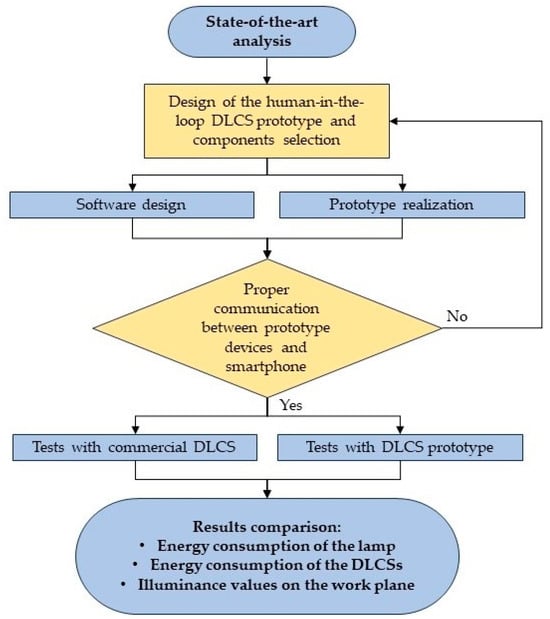
Figure 2.
Employed methodology flow diagram.
4.1. Experimental Setup
The experimental analysis was carried out in a room on the second floor of “G. Parolini Lab” at the University of L’Aquila (latitude 42°33′ N, longitude 13°37′ E), having a single west-facing window with no shading systems.
The room has dimensions of 4.20 m × 3.40 m, a height varying between 3.50 m and 2.45 m due to a pitched roof, and a window size of 1.50 m × 1.00 m, with a window-to-floor ratio (WFR) of 10.5%. Figure 3 shows the geometry of the room (Figure 3a) and 3D luminance modeling (Figure 3b) obtained using ReluxPro software (version 2022.3.3.0) [].
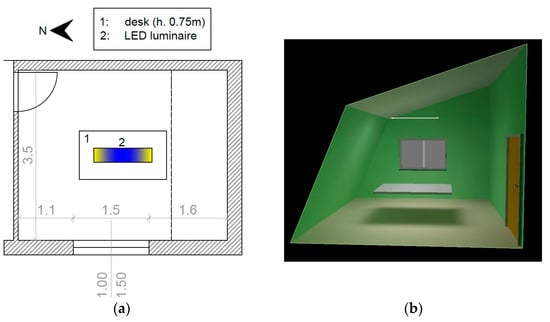
Figure 3.
The room used for the experimental campaigns: (a) geometry of the room; and (b) 3D luminance model of the room.
The lighting requirements, summarized in Table 1, are taken from standard EN 12464-1 [] for its intended use, namely. “Educational premises—Educational buildings—Computer work only (ref. no. 44.11 of the standard)”.
Inside the room, a Disano LED lamp, model 842 LED Panel R CRI80 [], was installed, having the characteristics shown in Table 2 and the photometry shown in Figure 4.
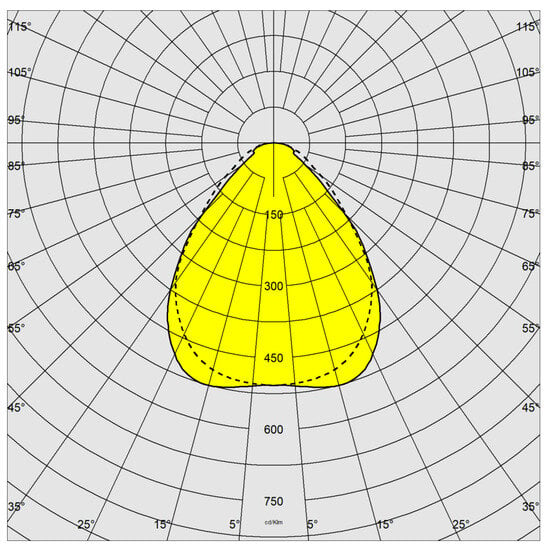
Figure 4.
Luminaire photometry (source: luminaire manufacturer [], Disano illuminazione, Milano, Italy.).

Table 1.
Lighting requirements of the room selected for the experimental analysis [].
Table 1.
Lighting requirements of the room selected for the experimental analysis [].
| Lighting Requirements | Value |
|---|---|
| Maintained illuminance | 300 lx |
| Illuminance uniformity | 0.6 |
| Color rendering index (CRI) | 80 |
| Unified glare rating (UGR) | 19 |

Table 2.
Technical specifications of LED lamp employed for the experimental analysis [].
Table 2.
Technical specifications of LED lamp employed for the experimental analysis [].
| Physical Quantity | Value |
|---|---|
| Dimensions (length × width) | 1195 × 295 mm |
| Weight | 3.465 kg |
| CRI | ≥80 |
| Luminous flux | 3600 lm |
| Maximum power consumption | 33 W |
| Correlated color temperature (CCT) | 4000 K |
| Luminous efficacy | 109 lm/W |
| UGR | <19 (EN 12464) |
Illuminance measurements were performed through an Extech Instruments illuminance meter, model SDL400, which has a measurement range of 0–100,000 [], placed on the center of the desk. The measurements were carried out in February 2023 and November 2023 and were obtained with an acquisition time step of 10 s to obtain data with a frequency useful for assessing the behavior of the control system and its sensitivity to daylight variations.
4.2. Lighting Scenarios
The architectures that were taken into consideration for the investigation of this work are divided into two scenarios, A and B.
The A scenario, reported in Figure 5, uses a commercial DLCS. The lighting is controlled using a digitally managed supply unit, in which the level can be set through a DALI bus. The control node is the previously mentioned B.E.G. PD4-M-1C, which is ceiling-mounted as the light. The system is installed in a room with a window that gives daylight direct access, so the sensor on the controller senses the daylight and the scattered light. The desired illuminance is set manually using the potentiometers on the controller, which requires access to the ceiling mount for at least the first installation. During this operation, the user has to set the desired target illuminance on the work plane manually by accessing the controller enclosure and using a screwdriver.
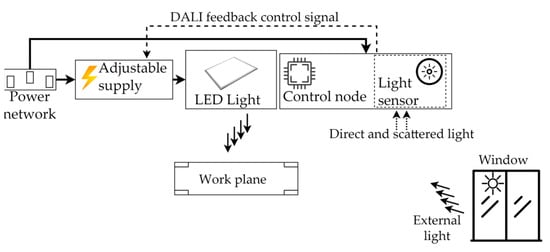
Figure 5.
Block scheme of the A scenario, a commercial device mounted on the ceiling at lamp height.
The work plane is a desk, where an illuminance value of 300 lux is requested []. Both the luminaire and the controller are monitored in terms of network power absorption.
The B scenario (Figure 6) represents the configuration used for testing the experimental prototype. The structure is similar to A, with the difference being that the control node, including the light sensor, is placed on the work plane. In this case, the light is directly sensed on the interested surface. The controller is managed in wireless mode using a smartphone device to ease user accessibility. The node is built using a custom structure and is aimed at enhancing functionality and achieving better energy performance.
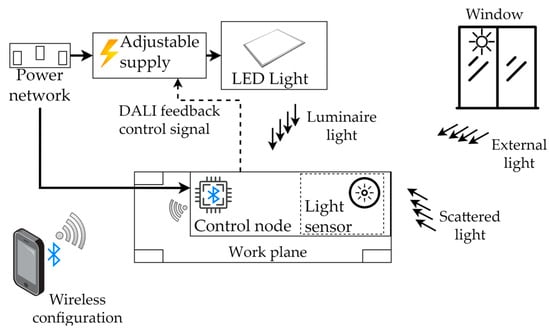
Figure 6.
The block scheme of the B scenario has a custom controller with the sensor on the work plane and a wireless user interface.
Figure 7 shows the cross-section of the experimental setup during the aforementioned tests, representing the lamp, lux meter, controller, and desk.
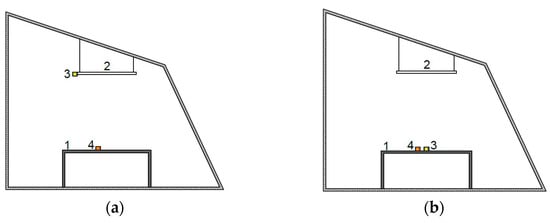
Figure 7.
Cross-section of the room during testing: desk (1), lamp (2), controller (3), lux meter (4). (a) Commercial controller case; and (b) custom controller case.
Table 3 reports a synthetic comparison of the features of the two test scenarios.

Table 3.
Synthetic comparison of the test scenarios.
4.3. Custom Node Hardware Architecture
In this section, the hardware structure of the custom controller will be described. The previously mentioned commercial unit can be set only manually, acting on the knobs located on its enclosure. For the sake of increased usability and comfort, we designed a custom controller that can be managed with a smartphone and communicates by bluetooth low energy (BLE) []. The device is aimed to offer flexibility in the setup of the desired lighting parameters, as all the operations can easily be executed from a smartphone enabled with BLE connectivity without the need to manually access the lighting control device. The node is based on the nRF52840 microcontroller from Nordic Semiconductor. This element features integrated BLE support, native Universal Serial Bus (USB), and serial interfaces. The inter-integrated circuit (I2C) bus is used to communicate with a VEML7700 [] light sensor and a LW-14 [] interface for IEC62386 [] DALI protocol. These elements are mounted on a custom-printed circuit board and enclosed in a box with accesses for USB, DALI wires, and a slot for the light sensor surface. The control node is supplied directly from the grid at 220 V Alternate Current (AC); thus, Recom RAC02 [] Direct Current converters are employed (AC-DC converters). Figure 8 shows the block schematic. The hardware development cost of the custom controller is inferior to one hundred euros.
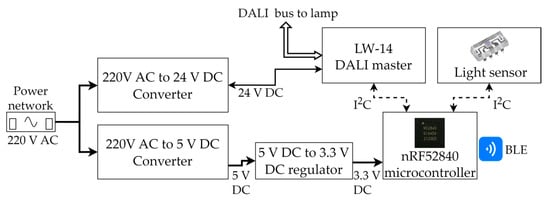
Figure 8.
Block scheme of the custom light controller.
The wireless light controller has an operation flow, as depicted in Figure 9. When the device is connected to the power network, it enters Bluetooth central mode, waiting for a connection. When a user is connected, the commands are available to be issued for lamp control. The user can set the desired light level, and then enter the tracking mode that is used to keep the light at a power, such as to give the desired work plane illuminance. The smartphone application allows several functions to be performed, such as manual switching, increase or decrease of the luminous flux, choice of the setpoint value for the work plane illuminance, and enabling the automatic dimming mode. The user connection with the controller is available in the range of BLE-enabled devices, usually in the range of ten to thirty meters.
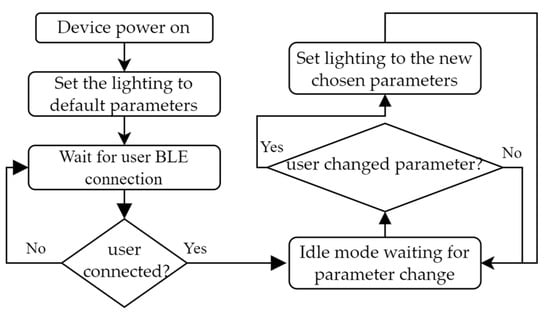
Figure 9.
Flow diagram of the light controller operation.
5. Results
The executed measurements have the intent of preliminarily quantifying the power consumption of each element during a test period that emulates normal lighting usage. Moreover, the tests have been performed to verify the functionality of the prototype system and its ability to maintain the desired light intensity on the work plane effectively. The experimental phases were conducted by imposing an illuminance setpoint of 450–500 lx for both the proposed prototype and the commercial instrument. The system was left in free-running mode for the length of 1 h. All the tests were conducted in the period of 7–8 February 2023 and 27–28 November 2023 in such a way as to have different external light illuminance in each test. The measurement setup is schematized as shown in Figure 10. A Hioki 3333 [] power meter measured the lamp power dissipation that was in the range of tens of watts. In contrast, a more sensitive custom power meter was used to obtain the controller power dissipation that was in the order of magnitude of the watt. These elements have a serial output where the digital data are transmitted to a calculator enabled with a LabVIEW [] interface that gathers the measurements and logs the data. The values of voltage and current read from the power meters are multiplied to obtain the total power. The previously mentioned lux meter model SDL400 was placed on the work plane to record the illuminance on the desk surface.
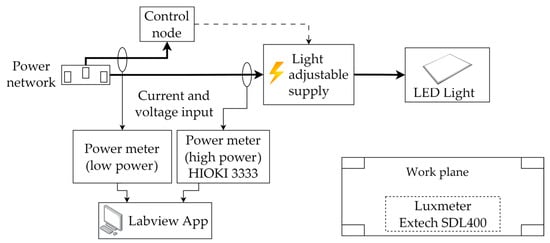
Figure 10.
Measurement setup for the systems under investigation.
The measured power is reported in volt-ampere (VA), as the lighting supply introduces a power draw composed partly of reactive power. The following Figure 11 and Figure 12 show some measurements performed to compare the commercial and custom DLCSs. Lamp-power-, controller-power-, and desk-measured illuminance during the test time slots in February 2023 and November 2023 are shown in Figure 11 and Figure 12, respectively. The measurements were performed in the same room during the morning hours, ranging from 10:00 to 13:00 for both days. The external sun intensity for the measurement periods was, on average, 525 W/m2 for the first test period and 126 W/m2 for the test period of November 2023. These data, monitored by a local weather station, have been provided by CETEMPS—Center of Excellence [].
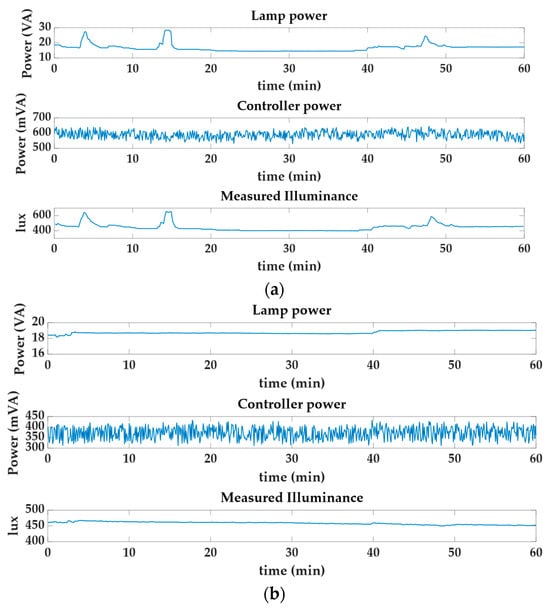
Figure 11.
Measurements were performed in February 2023: (a) commercial controller; and (b) custom controller.
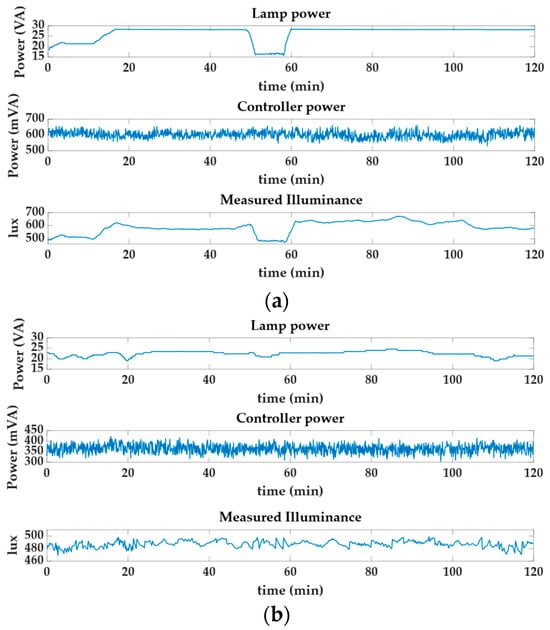
Figure 12.
Measurements were performed in November 2023: (a) commercial controller; and (b) custom controller.
We should take into consideration the fact that the tests were performed in different external daylight conditions. The first measurement was performed in sunny external conditions with moderately intense wind conditions. The second measurement was performed in a mostly cloudy sky with steadier daylight conditions.
Table 4 reports the average power draws and desk illuminance variation of the systems under investigation. It is important to note that the average lamp power depends on the external daylight situation.

Table 4.
Average power draws and desk illuminance variation.
It is possible to observe that the commercial device had difficulties in keeping a constant illuminance value over the work plane, as the direct light from outside influenced the behavior, leading to a poor performance. Differently, the custom system was better able to maintain the illuminance at the desk around the set value. As we can observe in Table 3, the power consumption of the novel DLCS is reduced with respect to that of the compared commercial unit.
6. Discussion
Based on the results obtained, useful considerations can be made about the DLCS prototype proposed in this work and its comparison with a commercial one. The desk-located sensing has offered better performance in the tracking of a desired illuminance value. This is in accordance with the previously cited works [,] that explain that the ceiling-located sensors are more affected by the changes in the light conditions of the room, such as light reflections. However, the proposed prototype based on a desk-located sensor can be most affected by the presence of moving objects and people. This aspect can lead to further developments of the systems toward the direction of possible shading pattern recognitions.
The proposed controller, at the prototypal stage, requires pre-existent cabling for the DALI bus. This is not unusual to have in an office scenario but could be less common in a residential house. The development of both the wireless sensor and controller can be one of the future developments for the controller system, to have a moveable and totally non-wire-constrained apparatus.
The commercial device used for this study was not easily configurable, as it needed a manual approach to set the desired illuminance value. This can be a drawback in a larger-scale implementation.
The experimental analysis also showed that the custom system has an average consumption of about 40% lower than the commercial controller. This result is very interesting considering that a controller potentially remains active all the time, i.e., for 8760 h/year. The increased user-friendliness of the system can offer an increased interaction of the human in lighting control, achieving better performances in terms of comfort. This adds to the previously discussed energy savings.
In Table 5, the strengths-and-weaknesses comparison of the proposed system and the tested commercial system is summarized. The authors suggest that this could be valid for other commercially available DLCSs, as those are based on the same sensing approach as the studied one.

Table 5.
Strengths and weaknesses of the studied DLCSs.
7. Conclusions
In this work, we proposed a human-in-the-loop DLCS for DALI-based luminaires. The system is aimed to offer easy configurability and low power consumption and is based on commercially available electronic components. In this paper, we compared the novel system with a state-of-the-art commercial DLCS for DALI luminaires, obtaining good results in terms of illuminance management, power performance, and user-friendliness. The systems were compared in a controlled scenario, and the test methods were described.
The main findings of the work can be summarized as follows:
- The proposed system has shown the ability to dim the luminaire intensity to keep the illuminance on the target work plane around the desired level with an error in the order of ten lux;
- The power consumption is considerably less than that of the comparison device (about 40% less);
- The prototype DLCS has allowed the user’s direct interaction with the control system, allowing them to obtain a human-in-the-loop controller.
However, some limitations of the prototype should be further investigated, in particular, the possibility of expanding its functionality by considering other variables to control, including, for example, occupancy, shading, and so on.
The research that has been carried out leads to promising results for developing a system that includes more lighting control features, possibly integrating data analytics to assess the energetic performance of the system.
Moreover, future developments of the system will be the development of a miniaturized controller fully integrated into the commercial power supplies of the luminaires.
Another development aims to implement low-power wireless sensors to remove all the wiring constraints, possibly integrating intelligent calibration techniques to overcome the disadvantages of on-work-plane light sensing.
Author Contributions
Conceptualization, T.d.R. and M.R.; methodology, T.d.R., M.R. and A.L.; software, M.R. and A.L.; validation, T.d.R., M.R. and D.A.; formal analysis, T.d.R., M.R. and D.A.; investigation, T.d.R. and M.R.; resources, T.d.R. and M.R.; data curation, T.d.R. and M.R.; writing—original draft preparation, T.d.R. and M.R.; writing—review and editing, V.S. and D.A.; and supervision, V.S. and D.A. All authors have read and agreed to the published version of the manuscript.
Funding
This research received no external funding.
Data Availability Statement
The datasets presented in this article are not readily available because the data are part of an ongoing study. Requests to access the datasets should be directed to tullio.derubeis@univaq.it.
Conflicts of Interest
The authors declare no conflict of interest.
References
- González-Torres, M.; Pérez-Lombard, L.; Coronel, J.F.; Maestre, I.R.; Yan, D. A Review on Buildings Energy Information: Trends, End-Uses, Fuels and Drivers. Energy Rep. 2022, 8, 626–637. [Google Scholar] [CrossRef]
- Delmastro, C.; de Bienassis, T.; Goodson, T.; Lane, K.; la Marois, J.-B.; Martinez-Gordon, R.; Husek, M. IEA Buildings Report; GlobalABC: Paris, France, 2022. [Google Scholar]
- Al-Shargabi, A.A.; Almhafdy, A.; Ibrahim, D.M.; Alghieth, M.; Chiclana, F. Buildings’ Energy Consumption Prediction Models Based on Buildings’ Characteristics: Research Trends, Taxonomy, and Performance Measures. J. Build. Eng. 2022, 54, 104577. [Google Scholar] [CrossRef]
- Liu, Z.; Zhou, Q.; Tian, Z.; He, B.; Jin, G. A Comprehensive Analysis on Definitions, Development, and Policies of Nearly Zero Energy Buildings in China. Renew. Sustain. Energy Rev. 2019, 114, 109314. [Google Scholar] [CrossRef]
- Economidou, M.; Todeschi, V.; Bertoldi, P.; D’Agostino, D.; Zangheri, P.; Castellazzi, L. Review of 50 years of EU Energy Efficiency Policies for Buildings. Energy Build. 2020, 225, 110322. [Google Scholar] [CrossRef]
- De Rubeis, T.; Gentile, N.; Smarra, F.; D’Innocenzo, A.; Ambrosini, D.; Paoletti, D. A novel method for daylight harvesting optimization based on lighting simulation and data-driven optimal control. In Proceedings of the 16th IBPSA Conference, Rome, Italy, 2–4 September 2019. [Google Scholar] [CrossRef]
- De Rubeis, T.; Giacchetti, L.; Paoletti, D.; Ambrosini, D. Building Energy Performance Analysis at Urban Scale: A Supporting Tool for Energy Strategies and Urban Building Energy Rating Identification. Sustain. Cities Soc. 2021, 74, 103220. [Google Scholar] [CrossRef]
- Nesticò, A.; Macchiaroli, M.; Pipolo, O. Historic buildings and energetic requalification—A model for the selection of technologically advanced interventions. In Computational Science and Its Applications—Lecture Notes in Computer Science, Proceedings of the 15th International Conference—ICCSA 2015, Banff, AB, Canada, 22–25 June 2015; Gervasi, O., Ed.; Springer: Cham, Switzerland, 2015; Volume 9157, p. 9157. [Google Scholar] [CrossRef]
- Li, D.H.W.; Lam, J.C. Evaluation of Lighting Performance in Office Buildings with Daylighting Controls. Energy Build. 2001, 33, 793–803. [Google Scholar] [CrossRef]
- Shen, E.; Hu, J.; Patel, M. Energy and Visual Comfort Analysis of Lighting and Daylight Control Strategies. Build. Environ. 2014, 78, 155–170. [Google Scholar] [CrossRef]
- Li, D.H.W.; Lam, J.C.; Wong, S.L. Daylighting and Its Effects on Peak Load Determination. Energy 2005, 30, 1817–1831. [Google Scholar] [CrossRef]
- De Rubeis, T.; Smarra, F.; Gentile, N.; D’innocenzo, A.; Ambrosini, D.; Paoletti, D. Learning Lighting Models for Optimal Control of Lighting System via Experimental and Numerical Approach. Sci. Technol. Built Environ. 2021, 27, 1018–1030. [Google Scholar] [CrossRef]
- MacNaughton, P.; Woo, M.; Tinianov, B.; Boubekri, M.; Satish, U. Economic Implications of Access to Daylight and Views in Office Buildings from Improved Productivity. J. Appl. Soc. Psychol. 2021, 51, 1176–1183. [Google Scholar] [CrossRef]
- Aries, M.; Aarts, M.; van Hoof, J. Daylight and Health: A Review of the Evidence and Consequences for the Built Environment. Light. Res. Technol. 2015, 47, 6–27. [Google Scholar] [CrossRef]
- De Rubeis, T.; Nardi, I.; Muttillo, M.; Ranieri, S.; Ambrosini, D. Room and Window Geometry Influence for Daylight Harvesting Maximization—Effects on Energy Savings in an Academic Classroom. Energy Procedia 2018, 148, 1090–1097. [Google Scholar] [CrossRef]
- Koo, S.Y.; Yeo, M.S.; Kim, K.W. Automated Blind Control to Maximize the Benefits of Daylight in Buildings. Build. Environ. 2010, 45, 1508–1520. [Google Scholar] [CrossRef]
- Bourgeois, D.; Reinhart, C.; Macdonald, I. Adding Advanced Behavioural Models in Whole Building Energy Simulation: A Study on the Total Energy Impact of Manual and Automated Lighting Control. Energy Build. 2006, 38, 814–823. [Google Scholar] [CrossRef]
- Yu, X.; Su, Y. Daylight Availability Assessment and Its Potential Energy Saving Estimation—A Literature Review. Renew. Sustain. Energy Rev. 2015, 52, 494–503. [Google Scholar] [CrossRef]
- Shen, E.; Hong, T. Simulation-Based Assessment of the Energy Savings Benefits of Integrated Control in Office Buildings. Build. Simul. 2009, 2, 239. [Google Scholar] [CrossRef]
- Shi, J.; Yu, N.; Yao, W. Energy Efficient Building HVAC Control Algorithm with Real-Time Occupancy Prediction. Energy Procedia 2017, 111, 267–276. [Google Scholar] [CrossRef]
- Kaminska, A.; Ożadowicz, A. Lighting Control Including Daylight and Energy Efficiency Improvements Analysis. Energies 2018, 11, 2166. [Google Scholar] [CrossRef]
- Kocabey, S.; Ekren, N. A New Approach for Examination of Performance of Interior Lighting Systems. Energy Build. 2014, 74, 1–7. [Google Scholar] [CrossRef]
- Díaz-Vilariño, L.; Lagüela, S.; Armesto, J.; Arias, P. Indoor Daylight Simulation Performed on Automatically Generated As-Built 3D Models. Energy Build. 2014, 68, 54–62. [Google Scholar] [CrossRef]
- Park, J.Y.; Ouf, M.M.; Gunay, B.; Peng, Y.; O’Brien, W.; Kjærgaard, M.B.; Nagy, Z. A Critical Review of Field Implementations of Occupant-Centric Building Controls. Build. Environ. 2019, 165, 106351. [Google Scholar] [CrossRef]
- Tan, F.; Caicedo, D.; Pandharipande, A.; Zuniga, M. Sensor-Driven, Human-in-the-Loop Lighting Control. Light. Res. Technol. 2018, 50, 660–680. [Google Scholar] [CrossRef]
- Bellia, L.; Fragliasso, F. Automated Daylight-Linked Control Systems Performance with Illuminance Sensors for Side-Lit Offices in the Mediterranean Area. Autom. Constr. 2019, 100, 145–162. [Google Scholar] [CrossRef]
- Bellia, L.; Fragliasso, F.; Stefanizzi, E. Why Are Daylight-Linked Controls (DLCs) Not so Spread? A Literature Review. Build. Environ. 2016, 106, 301–312. [Google Scholar] [CrossRef]
- Odiyur Vathanam, G.S.; Kalyanasundaram, K.; Elavarasan, R.M.; Hussain Khahro, S.; Subramaniam, U.; Pugazhendhi, R.; Ramesh, M.; Gopalakrishnan, R.M. A Review on Effective Use of Daylight Harvesting Using Intelligent Lighting Control Systems for Sustainable Office Buildings in India. Sustainability 2021, 13, 4973. [Google Scholar] [CrossRef]
- Beccali, M.; Bonomolo, M.; Ciulla, G.; Lo Brano, V. Assessment of Indoor Illuminance and Study on Best Photosensors’ Position for Design and Commissioning of Daylight Linked Control Systems: A New Method Based on Artificial Neural Networks. Energy 2018, 154, 466–476. [Google Scholar] [CrossRef]
- Tsangrassoulis, A.; Doulos, L.; Mylonas, A. Simulating the Impact of Daytime Calibration in the Behavior of a Closed Loop Proportional Lighting Control System. Energies 2021, 14, 7056. [Google Scholar] [CrossRef]
- Lampert, C. Smart Switchable Glazing for Solar Energy and Daylight Control. Sol. Energy Mater. Sol. Cells 1998, 52, 207–221. [Google Scholar] [CrossRef]
- Kirankumar, G.; Saboor, S.; Vali, S.S.; Mahapatra, D.; Talanki Puttaranga Setty, A.B.; Kim, K.-H. Thermal and Cost Analysis of Various Air Filled Double Glazed Reflective Windows for Energy Efficient Buildings. J. Build. Eng. 2020, 28, 101055. [Google Scholar] [CrossRef]
- Pereira, J.; Teixeira, H.; Gomes, M.D.G.; Moret Rodrigues, A. Performance of Solar Control Films on Building Glazing: A Literature Review. Appl. Sci. 2022, 12, 5923. [Google Scholar] [CrossRef]
- Futagami, T.; Yano, T.; Huang, C.; Enohara, T. Experimental Evaluation for Daylight-linked Gradation Lighting Control Using Image-based Motion Sensors. IEEJ Trans. Electr. Electron. Eng. 2020, 15, 723–732. [Google Scholar] [CrossRef]
- Ahmed, R.; Oh, S.J.; Mehmood, M.U.; Kim, Y.; Jeon, G.; Han, H.J.; Lim, S.H. Computer Vision and Photosensor Based Hybrid Control Strategy for a Two-Axis Solar Tracker—Daylighting Application. Sol. Energy 2021, 224, 175–183. [Google Scholar] [CrossRef]
- Kim, M.; Tzempelikos, A. Performance Evaluation of Non-Intrusive Luminance Mapping towards Human-Centered Daylighting Control. Build. Environ. 2022, 213, 108857. [Google Scholar] [CrossRef]
- Wu, Y.; Kämpf, J.H.; Scartezzini, J.-L. Design and Validation of a Compact Embedded Photometric Device for Real-Time Daylighting Computing in Office Buildings. Build. Environ. 2019, 148, 309–322. [Google Scholar] [CrossRef]
- Sarkar, A.; Fairchild, M.; Salvaggio, C. Integrated Daylight Harvesting and Occupancy Detection Using Digital Imaging; Blouke, M.M., Bodegom, E., Eds.; SPIE: Bellingham, WA, USA, 2008; p. 68160F. [Google Scholar]
- Winkler, T.; Rinner, B. Security and Privacy Protection in Visual Sensor Networks. ACM Comput. Surv. 2014, 47, 1–42. [Google Scholar] [CrossRef]
- López-Lovillo, R.M.; Domínguez-Amarillo, S.; Sendra, J.J.; Acosta, I. How Can a Daylighting and User-Oriented Control System Be Configured? A State-of-the-Art Critical Review. J. Build. Eng. 2023, 64, 105704. [Google Scholar] [CrossRef]
- ul Haq, M.A.; Hassan, M.Y.; Abdullah, H.; Rahman, H.A.; Abdullah, M.P.; Hussin, F.; Said, D.M. A Review on Lighting Control Technologies in Commercial Buildings, Their Performance and Affecting Factors. Renew. Sustain. Energy Rev. 2014, 33, 268–279. [Google Scholar] [CrossRef]
- Pandharipande, A.; Caicedo, D. Daylight Integrated Illumination Control of LED Systems Based on Enhanced Presence Sensing. Energy Build. 2011, 43, 944–950. [Google Scholar] [CrossRef]
- Caicedo, D.; Pandharipande, A.; Willems, F.M.J. Daylight-Adaptive Lighting Control Using Light Sensor Calibration Prior-Information. Energy Build. 2014, 73, 105–114. [Google Scholar] [CrossRef]
- Van de Meugheuvel, N.; Pandharipande, A.; Caicedo, D.; van den Hof, P.P.J. Distributed Lighting Control with Daylight and Occupancy Adaptation. Energy Build. 2014, 75, 321–329. [Google Scholar] [CrossRef]
- Pandharipande, A.; Caicedo, D. Smart Indoor Lighting Systems with Luminaire-Based Sensing: A Review of Lighting Control Approaches. Energy Build. 2015, 104, 369–377. [Google Scholar] [CrossRef]
- Cheng, Y.; Fang, C.; Yuan, J.; Zhu, L. Design and Application of a Smart Lighting System Based on Distributed Wireless Sensor Networks. Appl. Sci. 2020, 10, 8545. [Google Scholar] [CrossRef]
- Nagy, Z.; Yong, F.Y.; Frei, M.; Schlueter, A. Occupant Centered Lighting Control for Comfort and Energy Efficient Building Operation. Energy Build. 2015, 94, 100–108. [Google Scholar] [CrossRef]
- Papinutto, M.; Boghetti, R.; Colombo, M.; Basurto, C.; Reutter, K.; Lalanne, D.; Kämpf, J.H.; Nembrini, J. Saving Energy by Maximising Daylight and Minimising the Impact on Occupants: An Automatic Lighting System Approach. Energy Build. 2022, 268, 112176. [Google Scholar] [CrossRef]
- Tang, S.; Kalavally, V.; Ng, K.Y.; Parkkinen, J. Development of a prototype smart home intelligent lighting control architecture using sensors onboard a mobile computing system. Energy Build. 2017, 138, 368–376. [Google Scholar] [CrossRef]
- Raspberrypi.com. Raspberry Pi 3. Available online: https://www.raspberrypi.com/products/raspberry-pi-3-model-b/ (accessed on 1 December 2023).
- Ramya, C.M.; Shanmugaraj, M.; Prabakaran, R. Study on ZigBee technology. In Proceedings of the 2011 3rd International Conference on Electronics Computer Technology, Kanyakumari, India, 8–10 April 2011; pp. 297–301. [Google Scholar]
- Gao, Y.; Cheng, Y.; Zhang, H.; Zou, N. Dynamic Illuminance Measurement and Control Used for Smart Lighting with LED. Measurement 2019, 139, 380–386. [Google Scholar] [CrossRef]
- De Rubeis, T.; Muttillo, M.; Pantoli, L.; Nardi, I.; Leone, I.; Stornelli, V.; Ambrosini, D. A First Approach to Universal Daylight and Occupancy Control System for Any Lamps: Simulated Case in an Academic Classroom. Energy Build. 2017, 152, 24–39. [Google Scholar] [CrossRef]
- Scorpio, M.; Ciampi, G.; Gentile, N.; Sibilio, S. Effectiveness of Low-Cost Non-Invasive Solutions for Daylight and Electric Lighting Integration to Improve Energy Efficiency in Historical Buildings. Energy Build. 2022, 270, 112281. [Google Scholar] [CrossRef]
- Choi, S.; Choi, A.; Sung, M. Cloud-Based Lighting Control Systems: Fatigue Analysis and Recommended Luminous Environments. Build. Environ. 2022, 214, 108947. [Google Scholar] [CrossRef]
- Kent, M.; Huynh, N.K.; Schiavon, S.; Selkowitz, S. Using Support Vector Machine to Detect Desk Illuminance Sensor Blockage for Closed-Loop Daylight Harvesting. Energy Build. 2022, 274, 112443. [Google Scholar] [CrossRef]
- Wang, Y.-C.; Chen, W.-T. An automatic and adaptive light control system by integrating wireless sensors and brain-computer interface. In Proceedings of the 2017 International Conference on Applied System Innovation (ICASI), Sapporo, Japan, 13–17 May 2017; pp. 1399–1402. [Google Scholar]
- Lalitha, V.; Kathiravan, S. A Review of Manchester, Miller, and FM0 Encoding Techniques. Smart Comput. Rev. 2014, 4, 481–490. [Google Scholar]
- Wu, W.; Wu, M.; Liu, Y. A design of embedded DALI controller. In Proceedings of the 2006 4th IEEE International Conference on Industrial Informatics, Singapore, 16–18 August 2006; pp. 1237–1240. [Google Scholar]
- Ma, Y.; Wobschall, D. A sensor network for buildings based on the DALI bus. In Proceedings of the 2007 IEEE Sensors Applications Symposium, San Diego, CA, USA, 6–8 February 2007; pp. 1–3. [Google Scholar]
- Wu, M.-L.; Kung, C.-M.; Lin, Y.-N. DALI-2 intelligent lighting control system. In Proceedings of the 2020 International Symposium on Computer, Consumer and Control (IS3C), Taichung, Taiwan, 13–16 November 2020; pp. 158–161. [Google Scholar]
- Wang, S.-C.; Liu, Y.-H.; Yuan-Lin, C.; Jyun-Yan, C. Development of DALI-based electronic ballast with energy saving control for ultraviolet lamps. In Proceedings of the 2010 8th IEEE International Conference on Industrial Informatics, Osaka, Japan, 13–16 July 2010; pp. 214–219. [Google Scholar]
- Beg-luxomat.com. Luxomat PD4-M-1C Datasheet. Available online: https://www.beg-luxomat.com/it/prodotti/luxomat/rilevatori-di-presenza-per-montaggio-a-soffitto/1-canale/pd4-m-1c/ (accessed on 1 December 2023).
- Relux.com. ReluxDesktop. Available online: https://relux.com/en/relux-desktop.html (accessed on 1 December 2023).
- UNI EN 12464-1; Light and Lighting—Lighting of Work Places—Part 1: Indoor Work Places. EN Standard: Plzen, Czech Republic, 2021. Available online: https://www.en-standard.eu/din-en-12464-1-light-and-lighting-lighting-of-work-places-part-1-indoor-work-places/ (accessed on 1 December 2023).
- Disano.it. 842 LED Panel—UGR < 19—CRI ≥ 80. Available online: https://www.disano.it/en/cat/disano/10502-recessed-modulars/35510-842-led-panel---ugr<19---cri%e2%89%a580/ (accessed on 1 December 2023).
- Vishay.com. Vishay Semiconductors VEML7700 Datasheet. Available online: https://www.vishay.com/docs/84286/veml7700.pdf (accessed on 1 December 2023).
- Codemercs.com. Code Mercenaries LW-14. Available online: https://codemercs.com/downloads/ledwarrior/LW14_Datasheet.pdf (accessed on 1 December 2023).
- Extech-Online.com. EXTECH SDL400. Available online: https://www.extech-online.com/index.php?main_page=product_info&cpath=78_21_33&products_id=418 (accessed on 1 December 2023).
- Gomez, C.; Oller, J.; Paradells, J. Overview and Evaluation of Bluetooth Low Energy: An Emerging Low-Power Wireless Technology. Sensors 2012, 12, 11734–11753. [Google Scholar] [CrossRef]
- Dali-Alliance.com. DALI Alliance IEC 62386 Standard. Available online: https://www.dali-alliance.org/dali/standards.html (accessed on 1 December 2023).
- Recom-Power.com. Recom RAC02 AC-DC Converters. Available online: https://recom-power.com/pdf/powerline_ac-dc/rac02-gb.pdf (accessed on 1 December 2023).
- Hioki.com. HIOKI 3333 Power HiTester. Available online: https://www.hioki.com/euro-en/products/power-meters/single-phase-ac/id_5908 (accessed on 1 December 2023).
- Kodosky, J. LabVIEW. Proc. ACM Program. Lang. 2020, 4, 1–54. [Google Scholar] [CrossRef]
- CETEMPS—Center of Excellence. Available online: http://cetemps.aquila.infn.it/ (accessed on 1 December 2023).
Disclaimer/Publisher’s Note: The statements, opinions and data contained in all publications are solely those of the individual author(s) and contributor(s) and not of MDPI and/or the editor(s). MDPI and/or the editor(s) disclaim responsibility for any injury to people or property resulting from any ideas, methods, instructions or products referred to in the content. |
© 2024 by the authors. Licensee MDPI, Basel, Switzerland. This article is an open access article distributed under the terms and conditions of the Creative Commons Attribution (CC BY) license (https://creativecommons.org/licenses/by/4.0/).